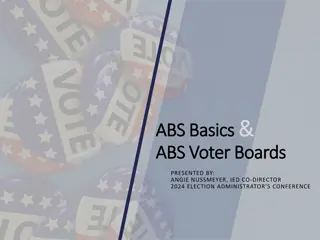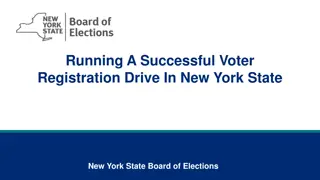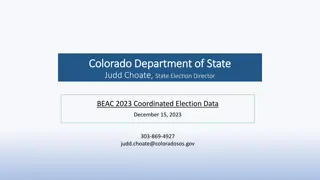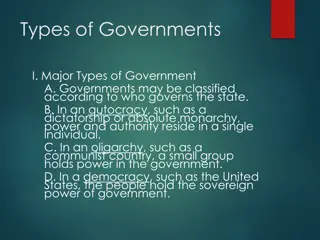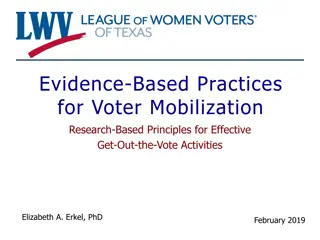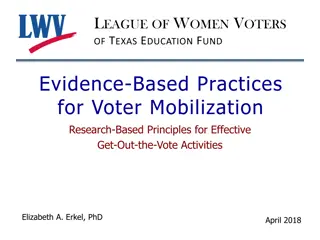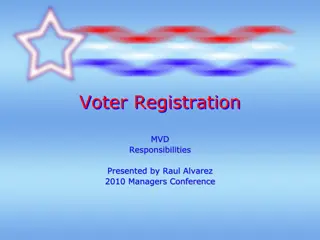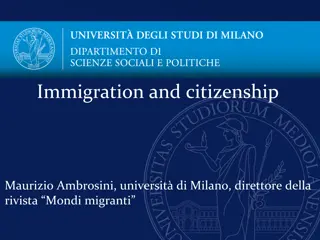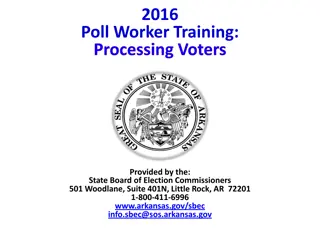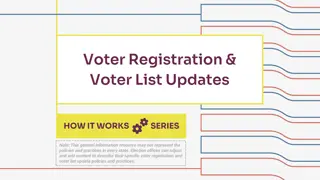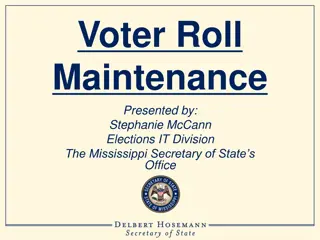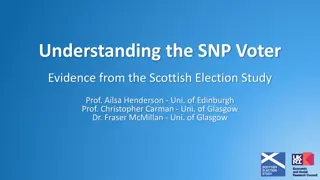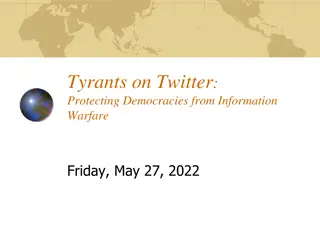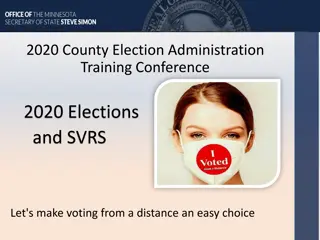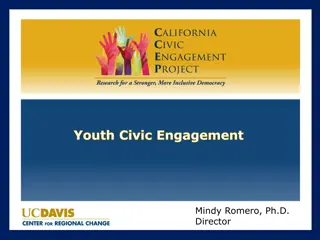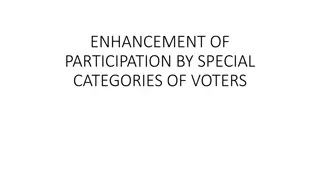Understanding Voter Policy Preferences in Representative Democracies
A study explores identifying multidimensional policy preferences of voters in representative democracies, focusing on the challenges of standard tools and common survey questions. The research aims to uncover how voters prioritize policy issues and which policies they prefer, beyond traditional survey methods, using a field experiment in Japan as a case study.
- Voter Preferences
- Policy Analysis
- Representative Democracies
- Japan Studies
- Conjoint Field Experiment
Download Presentation

Please find below an Image/Link to download the presentation.
The content on the website is provided AS IS for your information and personal use only. It may not be sold, licensed, or shared on other websites without obtaining consent from the author. Download presentation by click this link. If you encounter any issues during the download, it is possible that the publisher has removed the file from their server.
E N D
Presentation Transcript
Identifying Multidimensional Policy Preferences of Voters in Representative Democracies: A Conjoint Field Experiment in Japan Yusaku Horiuchi, Dartmouth College Daniel M. Smith, Harvard University Teppei Yamamoto, MIT Prepared for the workshop, Advancing Digital Scholarship in Japanese Studies: Innovations and Challenges, Harvard University, November 6, 2015
Abes surprise election The background: December 2012: LDP and coalition partner K meit won landslide victory over a fragmented opposition PM Abe made Abenomics his post-election economic agenda. Three arrows : Monetary policy Fiscal stimulus Structural reforms November 2014: Abe suddenly signaled his intention to dissolve House and call new elections
Abenomics on the ballot? Abe claimed election was to seek voter approval for decision to delay consumption tax increase Others interpreted the move as intended to strengthen Abe s hand for third arrow reforms; strike while opposition still weak The media interpreted the election as a referendum on Abenomics
Another landslide The results of the election were almost identical to 2012 Historically low turnout (53%) LDP won 291/475 seats (61.3%); together with K meit control 68.6% of seats Abe claimed that voters gave him a mandate for continuing Abenomics But did they really?
Limitations of Existing Toolkits Standard tools are ill-suited to identifying voters multidimensional policy preferences during an election campaign Actual election results don t accurately reflect voter preferences for specific policies We want to ask: How important is each policy issue relative to other issues? For each issue, which policy among proposed policies do voters prefer? Standard survey questions are not designed to answer these questions simultaneously
Common Survey Questions Typical surveys might ask questions such as... Which issue is most important to you employment, economic growth, nuclear power, or constitutional revision? Please rank employment, economic growth, nuclear power, and constitutional revision in order of their importance to you. With regard to employment, which policy do you prefer the most: A, B, C, etc.? These questions do not accurately reveal the preferences behind the actual choice of a party or candidate as a whole. In reality, voters evaluate multiple policy issues holistically and make a choice.
Conjoint Analysis Our solution: Conjoint analysis A novel measurement technique for multidimensional choices and preferences more accurate! We juxtaposed sets of multiple issue positions as hypothetical manifestos (policy bundles) Asked respondents to choose the most preferred bundle The first study to analyze public opinion about policy issues as bundles put together by parties in an actual national election
Design and Inference Experimental design: Each respondent compared policy bundles of 2 hypothetical parties (profiles) The order of 9 issues (attributes) was randomized For each issue, one of 3-4 policy proposals (levels) was randomly assigned Proposals were taken from actual party manifestos Each respondent then chose the most preferred party Respondent repeated the task 5 times Afterward, answered separate questions about demographics, support for Abe cabinet, and vote intention
Timeline: Fast! Election timeline: November 18: PM announces a snap election November 21: Lower house dissolved December 2 13: Campaign period (only 12 days) December 14: Election day Study timeline: November 19: IRB initial approvals December 3: Revised IRB approvals December 3 14: Sampling period (11 days)
Implementation We used the online survey company Research Now Panel of Japanese respondents pre-enrolled in their system Flexible targeting of respondents to meet demographic quotas, etc. Anyone can use it Open! Sample: Internet-based non-probability panel (N= 1,951) Matched to national census distributions on age, gender, region, education and income $3.15 per respondent (~$6,000 total cost) Cheap!
Policy Proposals 1 Consumption Tax Delay the tax increase until April 2017 and reduce other tax rates [LDP, Komeito] Delay until other reforms are made [PFG] Delay the tax increase indefinitely [DPJ, JIP, PLP] Stop the tax increase and reduce the existing tax [SDP, JCP] Employment Expand employment through job diversity [LDP, Komeito] Break down seniority system and liberalize labor market [JIP, PFG] Oppose deregulation of labor laws. Support regular (full-time) employment [DPJ, PLP, SDP, JCP] Monetary and Fiscal Policy Continue bold monetary policy and flexible fiscal policy [LDP, Komeito] Correct excessively loose monetary policy and reckless public works spending [DPJ, JIP, PFG] Oppose monetary and fiscal policies that widen inequality [PLP, SDP, JCP]
Policy Proposals 2 Economic Growth Strategy Break down regulatory protection of agriculture and health industries [LDP, JIP, PFG] Activate growth in rural areas and small businesses [Komeito] Increase consumption through employment and childrearing support [DPJ, PLP, SDP, JCP] Nuclear Power Restart nuclear reactors if proven safe [LDP, Komeito, PFG] Restart nuclear reactors only under strict safety guidelines [DPJ, JIP] Do not restart nuclear reactors [PLP, SDP, JCP] TPP (Trans-Pacific Partnership) Join TPP, but be prudent about liberalization [LDP, Komeito, DPJ] Join TPP, and actively promote liberalization [JIP, PFG] Oppose joining TPP [PLP, SDP, JCP]
Policy Proposals 3 Collective Self-Defense Approve collective self-defense under new laws [LDP, Komeito, PFG] Oppose the reinterpretation decision by the cabinet [DPJ, JIP, PLP] Oppose collective self-defense [SDP, JCP] Constitutional Revision Create a new constitution written by the Japanese people [LDP, DPJ, JIP, PFG] Add new rights to the existing constitution [Komeito, PLP] Oppose revision and protect the Peace Constitution" [SDP, JCP] National Assembly Seat Reduction Follow the recommendation of a special committee to create a better electoral system [LDP, Komeito] Drastically reduce the number of seats [JIP] Reduce the number of seats [DPJ, PFG, PLP] Oppose any reduction of proportional representation seats [SDP, JCP]
Three Main Questions 1. Which policy issues and positions are relatively more important in determining respondents choice over manifestos? 2. Does the effect of each policy position systematically vary across subgroups of respondents? 3. How do the actual party manifestos rank against each other?
Results 1: Relative Popularity of Positions All Respondents (N=1,922) Consumption Tax: Delay the tax increase until April 2017 and reduce other tax rates [LDP, Komeito] Delay until other reforms are made [PFG] Delay the tax increase indefinitely [DPJ, JIP, PLP] Stop the tax increase and reduce the existing tax [SDP, JCP] Employment: Expand employment through job diversity [LDP, Komeito] Break down seniority system and liberalize labor market [JIP, PFG] Oppose deregulation of labor laws. Support regular (full time) employment [DPJ, PLP, SDP, JCP] Monetary and Fiscal Policy: Continue bold monetary policy and flexible fiscal policy [LDP, Komeito] Correct excessively loose monetary policy and reckless public works spending [DPJ, JIP, PFG] Oppose monetary and fiscal policies that widen inequality [PLP, SDP, JCP] Economic Growth Strategy: Break down regulatory protection of agriculture and health industries [LDP, JIP, PFG] Activate growth in rural areas and small businesses [Komeito] Increase consumption through employment and childrearing support [DPJ, PLP, SDP, JCP] Nuclear Power: Restart nuclear reactors if proven safe [LDP, Komeito, PFG] Restart nuclear reactors only under strict safety guidelines [DPJ, JIP] Do not restart nuclear reactors [PLP, SDP, JCP] TPP (Trans Pacific Partnership): Join TPP, but be prudent about liberalization [LDP, Komeito, DPJ] Join TPP, and actively promote liberalization [JIP, PFG] Oppose joining TPP [PLP, SDP, JCP] Collective Self Defense: Approve collective self defense under new laws [LDP, Komeito, PFG] Oppose the reinterpretation decision by the cabinet [DPJ, JIP, PLP] Oppose collective self defense [SDP, JCP] Constitutional Revision: Create a new constitution written by the Japanese people [LDP, DPJ, JIP, PFG] Add new rights to the existing constitution [Komeito, PLP] Oppose revision and protect the "Peace Constitution" [SDP, JCP] National Assembly Seat Reduction: Follow the recommendation of a special committee to create a better elector al system [LDP, Komeito] Reduce the number of seats [DPJ, PFG, PLP] Drastically reduce the number of seats [JIP] Oppose any reduction of proportional representation seats [SDP, JCP] 0 5 10 10 5 Change in Support Compared to LDP's Position (%)
Results 2: Underlying Heterogeneity Effect Variation by Vote Intention (PR) Effect Variation by Vote Intention (PR) Employment Constitutional Revision Break down seniority system and liberalize labor market [JIP, PFG] Oppose revision and protect the "Peace Constitution" [SDP, JCP] LDP LDP DPJ DPJ Intend to Vote in PR for: JIP JIP Komeito Komeito PFG PFG JCP JCP PLP PLP SDP SDP Other Other Undecided Undecided Not Voting Not Voting 0.0 0.2 0.4 0.0 0.2 0.4 0.4 0.2 0.4 0.2
Results 3: Ranking of Party Manifestos Ranks of Actual Party Manifestos By Cabinet Approval All Respondents Approve Disapprove Neutral Most Most Most Most Popular Popular Popular Popular 20th 20th 20th 20th Rank (Percentile) Rank (Percentile) Rank (Percentile) Rank (Percentile) 40th 40th 40th 40th 60th 60th 60th 60th 80th 80th 80th 80th Least Popular Least Popular Least Popular Least Popular Komeito Komeito Komeito Komeito PFG PFG PFG PFG PLP JIP SDP JCP LDP LDP JIP PLP SDP JCP PLP SDP JCP JIP LDP PLP JIP SDP JCP LDP DPJ DPJ DPJ DPJ Manifesto Manifesto Manifesto Manifesto
Summary of Key Findings Media interpreted election as if it were an referendum on Abenomics After election, Abe claimed voters gave him a mandate to continue Abenomics
Summary of Key Findings On the contrary, Abenomics was seemingly unimportant to voters Moreover, the LDP s policy manifesto on the whole was the least popular Illustrates distortionary process of elections in translating policy preferences of voters into party vote choice New methods, tools, and resources made this kind of quick and relevant research possible!



